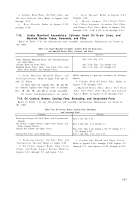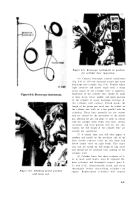TM-9-2815-200-35
ENGINE, WITH CONTAINER:TURBOSUPERCHARGED, DIESEL ,FUEL INJECTION ,90-DEGREE “V” TYPE, AIR - COOLED ,12 - CYLINDER , ASSEMBLY ;MODELS AVDS-1790-2M (2815-856-4996), AVDS-1790-2A AND AVDS-1790-2AM (2815-856-9005)
TECHNICAL MANUAL; DIRECT SUPPORT, GENERAL SUPPORT AND DEPOT MAINTENANCE MANUAL INCLUDING REPAIR PARTS AND SPECIAL TOOLS LISTS
TM-9-2815-200-35 - Page 544 of 779
RPM
Speed
Engine
No.
1800
3
2000
3
2200
2
2400
1
Note.
The mete r
readings
shall hav e
precedence over the visual reading.
8-2.
Crankcase and Induction System
Leakage
Test
a. General.
The engine crankcase and in-
duction systems should be pressure tested to
determine whether or not all connections are
water-tight and airtight. The complete assem-
bled engine is air-pressure tested for leaks. Leaks
that are present will be indicated by th e
presence of air bubbles when using a soap
solution on the joints as outlined below.
b.
Seal Openings.
Seal all openings as
directed in (1) through (3), below.
(1) Seal exhaust outlet openings on left and
right turbosuperchargers (fig. 8-2).
(2) Seal air inlet openings in left and right
turbosuperchargers (fig. 8-1).
(3) Seal oil filler and indicator tube caps
(fig. 1-2 or 1-7).
c. Remove Engine Cooling Fans.
Remov e
engine cooling vanes and cooling fans (fig. 4-34
and 4-35). The fans are removed in order to gain
access to several of the points of application of
the soap solution (f, below).
d. Install Sleeve Spacer.
Install two fan rotor
hub sleeve spacers -4910-795-7952, to prevent
oil seepage (fig. 4-87 ).
e.
Apply Air Pressure.
Install a tee-type
connection in crankcase breather tube (fig. 1-7).
Connect manometer and air hose connection in
tee. Apply air pressure and regulate air pressure
to indicate ten inches of mercury (in. Hg.) on
manometer.
f. Apply Soap Solution.
Apply soap solution
to all locations listed in (1) through (10), below.
(1) Air indication system and intak e
manifolds.
(2) Exhaust system.
(3) Pipe plugs in crankcase, oil pan, intake
manifold, exhaus t
manifold and crankcas e
damper and oil filter housing.
(4) All ventilation and vacuum line fittings.
This shall include all hose connections.
8-2
Robert Bosch
Visual
Meter No.
Light Gray
3.5
Light Gray
3.2
Haze
2.6
Clear
2.4
(5) Oil level indicator tube flange.
(6) Oil filler tube flange.
(7) Intercylinder preformed hoses.
(8) Injector nozzle and holder (at rocker
arm cover).
(9) Cylinder head oil drain system.
(10) Fan drive housings.
g. Minor Pressure Leakage.
Minor leak s
should be repaired (h, below) during this test
procedure and rechecked. However, some minor
leaks are acceptable providing the engine passes
the final acceptance test outlined below. Mark
any area where leaks are evident so that the leak
may be repaired.
(1) Reduce air pressure to zero.
(2) Remove seal (tape) from oil filler and
indicator tube caps and close caps securely.
(3) Pressurize system six inches of mercury
(in. Hg.).
(4) Test pressure loss after a five-minute
(exposure) time interval must not exceed 3-1 / 2
inches mercury (in. Hg.).
h.
Repair of Minor Pressure Leakage .
Examine marked areas (g, above) for loose hose
clamps, loose attaching parts at mounting
flanges, defective gaskets, or defective hoses,
whichever may exist. Repair leak by replacing
defective hoses or gaskets or by tightening loose
hose clamps or loose mounting flange attaching
parts.
i. Remove Sleeve Spacer.
Remove two fa n
rotor hub sleeve spacers - 4910-795-7952 (fig. 4-
87).
j. Installation of Cooling Fans.
Install engine
cooling fans (fig. 4-35).
k. Check Cooling Fan Clearance.
Check fan
blade clearance following instructions which
accompany figure 4-88.
l. Install Cooling Fan Vanes.
Install cooling
fan vanes (fig. 4-34).
8-3. Fuel and Oil System Leakage Test
a. General.
This test is made to determine if
an oil or fuel leak exists within the engine “V”
prior to and in conjunction with engine run-in
Back to Top




















